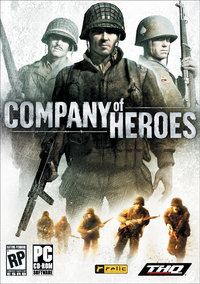With some of the highest scores awarded for a real-time strategy, being one of the Top 20 Metacritic All-Time High Scores, Company of Heroes ended up being one of those games I had little excuse not to try out, given that my PC could (just about) run it. Admittedly I’m unable to comment on the graphical splendour which seems to have charmed so many gamers’ hearts, as every setting on my screen reads either ‘low’ or ‘off’, but I’ve played a fair few strategy games over the years, and despite my early cynicism, Company of Heroes has warmed to me after a little experience on the online battlefields.
Whenever a game is released with a major historical theme, such as the ever popular World War II era, cries go up about the loss of realism to the gaming gods. Such and such would never happen, this and that never existed. Of course, many strategy games don’t even attempt to pander to the pedants of realism, and have been all the more successful for it (take the recent Supreme Commander, or any in the Command and Conquer series). Company of Heroes is no saint in this regard either, but its efforts to create a game at once realistic and fun have to be admired. There will always be players who complain about how developers could have stayed truer to real life, but Relic have done a good job in creating a game which at least seems realistic enough, and in ways which make the game fun to play. Shells fired at tanks have a chance of only glancing off the armour, and depending on the situation might even miss altogether; units under heavy fire become surpressed, limiting their movements and actions, or even pinned, leaving them helpless unless pulled out or relieved; and the variety of weapons and vehicles keep the tactics fresh and varied.




